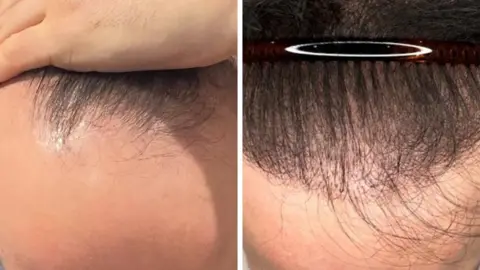 BBC
BBCI’m bald, and that bothered me for a long time.
It bothered me that I was bothered. But just one swipe down my Instagram feed reveals I’m not the only man who is self-conscious about his hair.
I’m greeted with videos and posts offering me hair transplants, regrowth tablets, thickening sprays, powders that fill gaps, and hair systems (once known as wigs or toupees).
These products promise to restore my “lost confidence” and stop my lack of hair from “holding back” my life.
But does the wealth of treatment options on offer mean attitudes towards hair loss have shifted? Is what was once viewed as something to be resigned to now seen as reversible, albeit at a cost?
According to the International Society of Hair Restoration Surgery (ISHRS), hair transplants are becoming more common around the world – and the people having them are getting younger.
This global collective of surgeons, doctors and experts found 95% of its members’ patients sought hair restoration surgery between the ages of 20 and 35 – and that’s something hair-loss surgeon Dr Nilofer Farjo confirms is mirrored in the UK.
When my hair first began to recede in my early 20s, I tried my best to cover it up, tactically styling and positioning it in a way that hid the new patches of scalp I hadn’t seen before.
Then, while out for my brother’s stag do in a Liverpool nightclub, something happened that I haven’t been able to forget since.
I had suggested we wear white t-shirts and carry permanent markers so people we met could leave funny messages on our shirts.
“Best man? Best comb-over,” one woman wrote.
I laughed it off at the time, but inside, I was crushed. It was clear my hair loss was now noticeable to other people. And from then on, I became more and more self-conscious about my thinning hair.

When I was younger, bald men were often the butt of jokes – but taking steps to regain lost hair seemed to be viewed as effeminate and vain. Still, I began to wonder if a hair transplant was my only option. Was that a possibility for someone like me? In my mind, they were only for rich people, and celebrities like Elton John.
Fast forward ten years, and social media and dating apps have made us all more aware of how we look, says Dr Farjo, and seeing celebrities and influencers being more open about hair transplants has normalised the procedure.
She says more and more young men are now choosing to treat their hair loss, and what might have once been deemed “vanity” is now considered “routine self-care”.
When I started considering having a hair transplant, I had just finished university, had little money, and no real idea how much the procedure might actually cost.
I began to do some research and discovered a nearby transplant clinic offering free consultations and monthly payment plans.
“You’re still quite young,” I remember the hair transplant consultant telling me, as he drew on my scalp with a felt-tip pin. “After this transplant, your hair could recede further. But you can just come and get it filled in.”
Despite the payment plan, I realised I couldn’t afford a hair transplant – especially if I’d have to come and get a top-up later in life.

Since my own consultation in Cardiff in 2014, I’ve heard about men travelling abroad in increasing numbers to countries like Turkey to have hair transplants. Dr Farjo says this is down to costs being “a fraction” of what they are in the UK.
But while the price may be attractive, she says there are concerns about industry practices, with limited regulations in place. Dr Farjo also warns that cheap, unregulated procedures, not only in Turkey, can sometimes lead to people needing “costly corrective surgery” to deal with scarring and “poor hairline design”.
But hair transplants in Turkey remain popular and there are many happy customers – including content creator, Ben Placito.
After jokey comments from his barber, Ben decided to consider having a hair transplant. And after months of research, he discovered it would be cheaper to have the procedure carried out in Turkey than in the UK.
Some quotes from Turkish clinics were “crazy cheap”, Ben says, offering surgery for around £1,500. But the 31-year-old chose not to go with the cheapest hair transplant on offer and instead selected a “premium” option.
Ben felt reassured about his chosen clinic after speaking to other men who had been there and had good experiences. Ben travelled to Turkey in 2022 to have the procedure, sharing his experience on his TikTok account.
“People have said to me ‘it’s the best thing you’ve done,'” Ben says. “I’m really happy I did it.”
 Ben Placito
Ben PlacitoAbout a year after I gave up on the idea of surgery, I came across an advert for a clinic offering non-surgical treatments, like finasteride tablets and minoxidil cream, which can be used to stimulate hair growth.
Finasteride is one of the most common pills for hair loss, taken by tens of thousands of men in the UK. It is only available by private prescription.
It works by preventing testosterone turning into another hormone called dihydrotestosterone (DHT) that can stop hair growing.
Minoxidil, originally a blood pressure medication, has hair growth as a side effect and is commonly sold in the form of a daily cream applied directly to the hair and scalp.
I paid several hundred pounds for a combined course of minoxidil and finasteride but the treatment requires consistent daily use, and I often forgot doses. Eventually, I realised I couldn’t justify the cost – or trust myself to stick with it. Health concerns also weighed on me, something the clinic had made clear.
According to a 2024 report by the Medicines and Healthcare products Regulatory Agency (MHRA), finasteride is linked to psychiatric issues like depression and suicidal thoughts, and can have side effects affecting sexual function.
The MHRA advises users to monitor symptoms and stop using the drug if adverse effects occur.
My experience was a decade ago, but the market for hair-loss medication has since exploded. Superdrug’s private online doctor service says it has seen a 68% increase in new patients requesting hair-loss services in the last three months versus the equivalent period last year.

Having given up on medication, I relied on hats and carefully positioned sunglasses that would “hide” my receding hair. If I was taking a photo with family or friends, I’d position the camera so it cropped out the top of my head.
Then in 2019, I began to see adverts for hair systems. These seamless-looking hair pieces are glued to a shaved scalp and blended with existing hair, with regular clinic visits for maintenance. This seemed like a side-effect-free, instant solution.
But I couldn’t shake the thought of suddenly appearing at work or family events with a full head of hair – everyone knew I was balding. I also questioned the legitimacy of the adverts. Were the results real? Or just the result of clever lighting and angles?
I had seen some people with systems telling their social media followers they could start peeling off in the middle of the day – and I dreaded that.
However, for 36-year-old Adam Lomax, who has male pattern baldness and trichotillomania (a mental health disorder where you can’t resist pulling out your own hair), a hair system was “life changing”.
Adam had already tried finasteride, which left him feeling anxious, depressed and low in libido.
“People have been really positive,” Adam says of the reception to his new hair. “The conversation around men’s hair loss has shifted massively – but you still get the odd troll on TikTok.”
 Adam Lomax
Adam LomaxIt’s clear there are plenty of options for men facing hair loss, but not every bald man sees losing their hair as something that needs to be fixed or prevented.
“The narrative around hair loss needs to change both socially and commercially,” says Tariq Kazemi, co-founder and CEO of skincare company Bld Bro, a brand which began life as a support group for bald men.
Tariq recalls a colleague poking fun at his bald spot during a shopping trip, and describing that as “like an ice pick to my heart”.
Tariq later shaved his head and noticed that jokes about his hair loss stopped. He chose not to pursue any form of hair restoration.
“Those industries prey on the fear and anxiety of young men,” he says. “We’ve been told it’s our identity, our confidence and our attractiveness that will all disappear with the hair on our head.”

In 2020, when the world went into coronavirus lockdown many people grew out their hair or attempted to cut it themselves.
By this time, the only remaining hair I had was around the back of my head and in a thin patch on the top of my forehead. I took the plunge and decided to shave my head. There was a freedom in skipping to the end stage of the balding process, and I’ve continued to shave my head ever since.
There’s so much social media noise around hair loss, and money to be made from men’s worries about it. But after speaking to different men about their hair loss experiences, it’s clear there is no single right way to feel happy with your appearance.
The anxiety I felt while I was losing my hair has gradually ebbed away and I feel more accepting of the way I look. I’ve come to terms with my baldness now and I prefer to be bald than balding.

#world #hair #restoration



